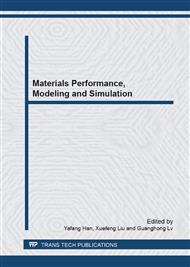[1]
D.C. TSAI, W.S. HWANG, Numerical simulation of solidification morphologies of Cu-0. 6Cr casting alloy using modified cellular automaton model, Transactions of Nonferrous Metals Society of China. 20 (2010) 1072-1077.
DOI: 10.1016/s1003-6326(09)60260-0
Google Scholar
[2]
Y. CHEN, Y.H. ZHAO, H. Hou, Numerical simulation for thermal flow filling process casting, Transactions of Nonferrous Metals Society of China. 16 (2006) 214-218.
Google Scholar
[3]
T.R. Vijayaram, S. Sulaiman, A.M.S. Hamouda, M.H.M. Ahmad, Numerical simulation of casting solidification in permanent metallic molds, Journal of Materials Processing Technology. 178 (2006) 29-33.
DOI: 10.1016/j.jmatprotec.2005.09.025
Google Scholar
[4]
J.J. Droux, Three-dimensional numerical simulation of solidification by an improved explicit scheme, Computer Methods in Applied Mechanics and Engineering. 85 (1991) 57-74.
DOI: 10.1016/0045-7825(91)90122-m
Google Scholar
[5]
Y.F. Chiu, W.S. Hwang, Mathematical modeling for the solidification heat-transfer phenomena during the reflow process of lead–tin alloy solder joint in electronics packaging, Applied Mathematical Modelling. 27 (2003) 565-579.
DOI: 10.1016/s0307-904x(03)00087-8
Google Scholar
[6]
H. HOU, Studies on Numerical Simulation for Liquid-Metal Filling and Solidification during Casting Process, Japan: Saitama Institute of Technology. (2005) 43-69.
Google Scholar
[7]
X.P. Zhang, S.M. Xiong, Q.Y. Xu, Numerical method to improve the computational efficiency of solidification simulation for the investment casting process, Materials Processing Technology. 173 (2006) 70-74.
DOI: 10.1016/j.jmatprotec.2005.09.030
Google Scholar
[8]
F. Mampaey, A numerical technique to increase the stability of the ADI method in solidification simulation, Journal of Computational and Applied Mathematics. 28 (1989) 297-308.
DOI: 10.1016/0377-0427(89)90341-5
Google Scholar
[9]
S. Karaa, J. Zhang, High order ADI Method for solving unsteady convection-diffusion problems, Journal of computational Physics. 198 (2004) 1-9.
DOI: 10.1016/j.jcp.2004.01.002
Google Scholar
[10]
Y.B. GE, Z.F. TIAN, W.Q. Wu, A high-order alternating direction implicit method for solving the high dimensional heat equations, J. University of Shanghai for science and technology. 29 (2007) 55-58.
Google Scholar
[11]
L.A. Zadeh, Fuzzy Sets, Information and Control. 8 (1965) 338-356.
Google Scholar
[12]
R. Scozzafava, B. Vantaggi, Fuzzy inclusion and similarity through coherent conditional probability, Fuzzy Sets and Systems. 160 (2009) 292 -305.
DOI: 10.1016/j.fss.2008.01.012
Google Scholar
[13]
C.Y. Zhang, H.Y. Fu, Similarity measures on three kinds of fuzzy sets, Pattern Recognition Letters. 27 (2006) 1307-1317.
DOI: 10.1016/j.patrec.2005.11.020
Google Scholar
[14]
Y.H. Li, D.L. Olson, Z. Qin, Similarity measures between intuitionistic fuzzy (vague) sets: A comparative analysis, Pattern Recognition Letters. 28 (2007) 278 -285.
DOI: 10.1016/j.patrec.2006.07.009
Google Scholar
[15]
S. Raha, A. Hossain, S. Ghosh, Similarity based approximate reasoning: fuzzy control, Journal of Applied Logic. (2008) 47 -71.
DOI: 10.1016/j.jal.2007.01.001
Google Scholar
[16]
S.H. Wei, S.M. Chen, A new approach for fuzzy risk analysis based on similarity measures of generalized fuzzy numbers, Expert Systems with Applications. 36 (2009) 589 -598.
DOI: 10.1016/j.eswa.2007.09.033
Google Scholar
[17]
Z.Y. Xu, S.C. Shang, W.B. Qian, A method for fuzzy risk analysis based on the new similarity of trapezoidal fuzzy numbers, Expert Systems with Applications. 37 (2010) 1290 -1297.
DOI: 10.1016/j.eswa.2009.07.015
Google Scholar
[18]
I. Georgescu, Similarity of fuzzy choice functions, Fuzzy Sets and Systems. 158 (2007) 1314 -1326.
DOI: 10.1016/j.fss.2007.01.009
Google Scholar


